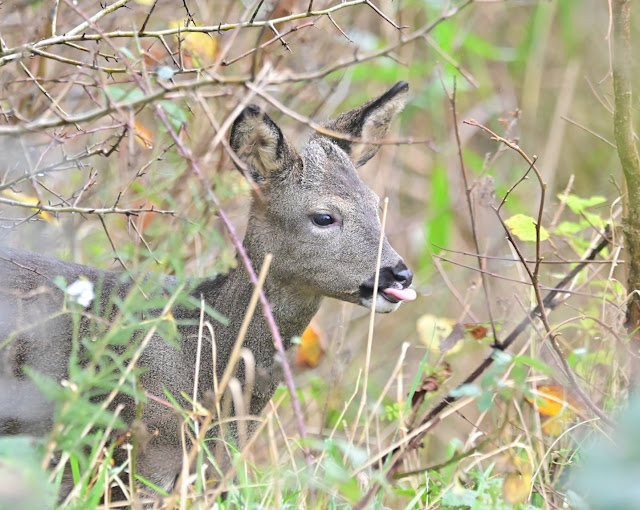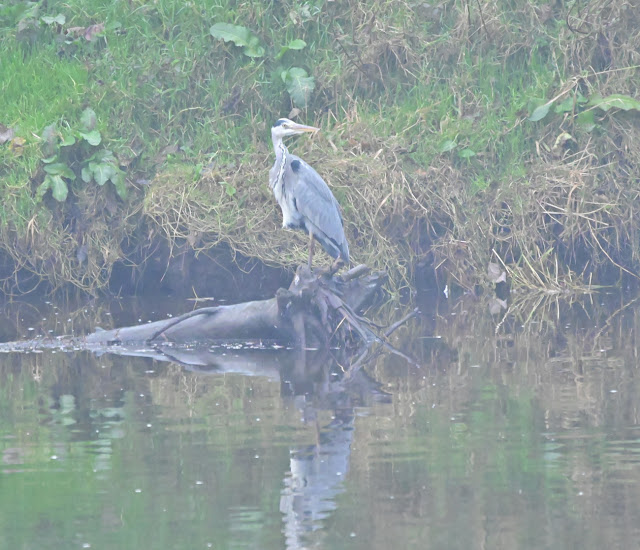From there we usually have a wander along the river but broke with tradition again and went to have a look at the other lake, although we did walk round it and through the woods in our 'normal' clockwise direction this time. From The Lookout we could see that similar work had been done to the island here too. The newly exposed expanse of mud was certainly attractive to the Lapwings, there were at least a couple of hundred roosting on there. Too far away for pics and with nothing else nearer we moved on to the next screen where a Buzzard flew over our heads calling but neither of us could get a pic before it wafted over the treetops and away. It's a pity IH couldn't be on safari with us today as Herons started with a bang and not an egret to be seen. This one, the first of the day, was stood opposite us.
Another was only a dozen or so yards to it's left.
This one had a little preen and a shimmy before stalking off onto the mud perhaps on the hunt for
Frogs, Toads or
Newts that had been disturbed by the machinary.
Just behind the hide a bird chattered which sounded like a
Cetti's Warbler and then clucked like a
Blackbird, we went to investigate and found a
Song Thrush deep in a
Willow bush, we don't recall them making those sorts of alarm(?) calls before. That's the thing with nature, there's always something new or unexpected even from 'common' things just around the corner - always something to learn.
Continuing our wander along the track we passed a Goldcrest that wouldn't show itself, other than that the wooded trail was quiet apart from the ticking of occasional Robins. We were hoping for some winter thrushes, Redwings and Fieldfares, but even Blackbirds were absent. Similarly the noisy part of the trrail along side the busy motorway was also devoid of life. Stopping at the next screen we got a better view of the recent management works.
If you look closely at the lower pic you might spot another
Heron.
This one too partook in a bit of preening.
Herons 3 - 0
Egrets! A flying start for Team Heron; can they keep the momentum going?
In the channel between us and the new mud island a small group of
Tufted Ducks mooched about. A couple of the females showed the '
Scaup-like' white blaze to their faces.
The males pose no such ID problems for the unwary or the duck novice.
A scan through the gulls we could see at the back o the island revealed no
Mediterranean Gulls, a shame as we'd already seen the other two of our 'Big Three' birds,
Coot and
Moorhen. In the bushes adjacent to the hide a small flock of
Long Tailed Tits wouldn't pose for pics.
Moving on towards the woods we passed an Elderberry tree impressively bedecked in blobs of moss.

This part of the British Isles' natural climax vegetation is Atlantic Temperate rainforest, of which only a tiny percentage of its original extent remains and so is one of the rareset natural habitiats on the planet. It is typified by high rainfall, obviously, and the fact that that rainfall gives rise to forest with trees covered in epiphytes aka plants wot grow on other plants usually trees - just like the pics above. It's a very rich and diverse habitat and there are,at last, significant moves to try to expand the area it covers, both here in the UK and neighbouring Ireland. Sadly there is also serious pressure from some communities NOT to help it expand into areas where it once stood. Anyway moving on into what is Lancashire's largest Ancient Woodland - not that it's very big at all - we hoped to come across some
Roe Deer but had to settle for a massive moss-covered
Bracket Fungus instead. Strangely there were very few other fungi to be found.
And then found some
Red Campion still in flower with
Herb Robert likewise a foot or so away.
No walk through a woodland in autumn is complete without a pic of a splendiferously golden tree.
We weren't the only ones getting pics of this beauty, a couple of ladies coming the other way had stopped to do the same and who could blame them, it was quite spectacular. But where were the birds, all along the path through the woods we'd only seen and heard a couple of
Robins and a
Blackbird. Passing the fields we came to the old hedge and that's where we found them. A nice selection of common birds were shuffling about in there including an unseen
Goldcrest and a brief male
Bullfinch which we hoped was going our way A few yards further on there is a small but very lively feeding station. We stopped here for a good while enjoying the comings and goings. Lots of
Blue and
Great Tits and a few
Chaffinches along with the ubiquitous
Grey Squirrels. Unlike Pennington Flash where the dozens of squirrels ruled the roost here the feeders were squirrel-proof expensive ones that worked well, closing the food ports when a squirrel manafged to get onto one, and the tables designed so that the squirrels couldn't jump onto them or clime the pole and access the food from beneath consequently there were far fewer
Grey Squirrrels here and they were only able to mop up any spillage the birds dropped. Well done Lancs Wildlife Trust.

Don't look too closely at the pics it was really dark under the bushes so the quality isn't up to much. Through the twiggery behind the feeders CR spotted a bit of movement which turned into a Roe Deer, not just one a second one was with it a few minutes later. After much waiting they almost came out into the open to show themselves.
Lots of cropping to try to get 'wrong' branches and bits of feeder out of the way.
Doing a bit of sniffing
and then tasting but not nibbling the twig.
Before too long they moved away to the right so we took the opportunity to get some shots of the other visitors to-ing and fro-ing around the feeders like this Dunnock.
and as many as five
Reed Buntings were about.
The male
Chaffinches are being to colour up nicely now.
Unlike the Reed Buntings above the Great Tits didn't pose for long and were difficult to get a pic of, as soon as you'd seen it and swung the camera round they were gone and we were trying not to take pics of them on the feeders themselves.
We could fill our boots with
Blue Tit pics as they were much more obliging.
Another movement in the back of the bushes was a
Great Spotted Woodpecker that didn't come to the front. A few minutes later more movement was seen, it was the
Roe Deer coming back. Again not really coming out into the open but staying tucked up at the back under and between the bushes behind the feeders - so lots of heavy cropping agian on the pics.
We're not sure what they were after on the ground there was no greenery down there but one of them did start to browse, first on
Hazel leaves.
Followed by a tongue tickling nibble on some
Nettle leaves.
Look at those pearly whites!
We had hoped to see Roe Deer and before we'd had this sighting we were getting a little disappointed we'd not seen any so far but this close up and prolonged sighting was way more than we could have wished for. Obviously we were being very quiet and they were very relaxed, relaxed enough to do a bit of grooming.
Relaxed that is until one heard us.
After a while they slunk off back into the undergrowth and we slunk off back to the car to collect our scran passing two more Roe Deer out in the open at the edge of the lake but they slunk off too before we could get a pic.
Before getting to the car park we called into the Visitor Village for another look at the new mud island where Heron #s 4 & 5 could be seen (and still no egrets).
After lunch we took the riverside path where we weren't expecting to find a
Redshank feeding on a shallow sandbank mid-stream.
It was now very misty and double gloomy as you can see. We were hoping for some
Goosanders which are often found here but found
Heron #6 instead.
Whilst watching a
Carrion Crow very intently wading around in the shallows, was it looking for a fish supper? the first
Little Egret of the day flew past went round the slight bend in the river and out of sight.
We like the way you can see the pebbles on the riverbed in the shadow of the bird in this pic.
Walking further down the river to see if we could find the Little Egret again we bumped into Heron #7
And yes just abit further on there was the
Little Egret too.
Leaving the river we headed back to the feeding station hoping for more
Roe Deer action, which as you know is never guaranteed. Around feeders
Blue Tits are guaranteed.
This afternoon the
Great Tits were more obliging.

The
Great Spotted Woodpecker was still about and equally hidden at the back of the bushes as earlier, no further visits from the
Roe Deer though. We failed to get any pics of the
Nuthatch that always seemed to land on the back side of the feeders grab a nut and vanish into the woods to eat or stash it. On that note we left to have another look over the mud island behind us. The
Lapwings were very skitttish taking flight at the merest thing...at least that's what we thought as we never saw anything that might be expected to upset them. We found one then four
Snipe well hidden in the mud but when they got up with the
Lapwings one time we saw there were actually about 70 of them, a fabulous sight. This is only about half of them after the 'wisp' split in two.
Still no sign of any
Mediterranean Gulls in the gull flock, apart from the many
Black Headed Gulls there was just a single
Lesser Black Back and two
Common Gulls. With one of the
Lapwing 'dreads' most of the gulls left along with neafrly all the
Lapwings. It was then we heard a
Wigeon whistle and looking through the reeds in front of us found a pair of them.

From here we went for a final look at the feeders where we found the only Coal Tit of the day having noted their absence on the day's previous visits





























































No comments:
Post a Comment